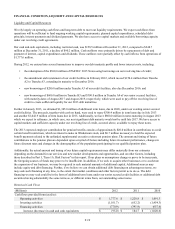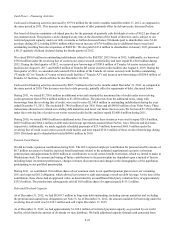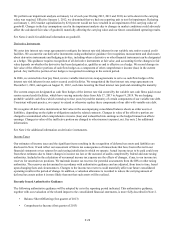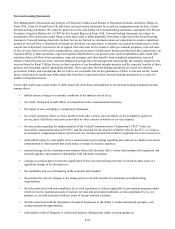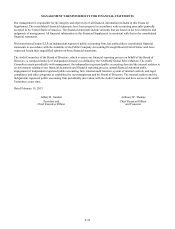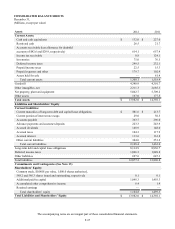Windstream 2012 Annual Report Download - page 125
Download and view the complete annual report
Please find page 125 of the 2012 Windstream annual report below. You can navigate through the pages in the report by either clicking on the pages listed below, or by using the keyword search tool below to find specific information within the annual report.
F-27
Pension Benefits
The annual costs of providing pension benefits are based on certain key actuarial assumptions, including the expected return on
plan assets, discount rate and healthcare cost trend rate. Our projected net pension income for 2013, which is estimated to be
approximately $5.5 million, was calculated based upon a number of actuarial assumptions, including an expected long-term rate
of return on qualified pension plan assets of 7.0 percent and a discount rate of 3.85 percent. If returns vary from the expected
rate of return or there is a change in the discount rate, the estimated net pension income could vary. In developing the expected
long-term rate of return assumption, we considered the plan's historical rate of return, as well as input from our investment
advisors. Historical returns of the plan were 9.79 percent since 1975, including periods in which it was sponsored by Alltel.
Projected returns on qualified pension plan assets were based on broad equity and bond indices and include a targeted asset
allocation of 25.0 percent to equities, 57.0 percent to fixed income assets and 18.0 percent to alternative investments, with an
aggregate expected long-term rate of return of approximately 7.0 percent. Lowering the expected long-term rate of return on the
qualified pension plan assets by 50 basis points (from 7.0 percent to 6.5 percent) would result in a decrease in our projected
pension income of approximately $4.9 million in 2013.
The discount rate selected is based on a hypothetical yield curve and associated spot rate curve adjusted to reflect the expected
cash outflows for pension benefit payments. The yield curve incorporates actual high-quality corporate bonds across the full
maturity spectrum and is developed from yields on Aa-graded, non-callable/putable bonds. The discount rate determined on this
basis was 3.85 percent at December 31, 2012. Lowering the discount rate by 25 basis points (from 3.85 percent to 3.60 percent)
would result in an increase in our projected pension expense of approximately $43.0 million in 2013. We recognize changes in
the fair value of plan assets and actuarial gains and losses due to actual experience differing from the various actuarial
assumptions, including changes in our pension obligation, as pension expense or income in the fourth quarter each year.
The Pension Protection Act of 2006 ("PPA") was signed into law on August 17, 2006. In general, PPA changed the rules
governing the minimum contribution requirements for funding a qualified pension plan on an annual basis without paying
excise tax penalties. Among other requirements, PPA changed the assumptions used to calculate the minimum lump-sum benefit
payments, and applied benefit restrictions to plans below certain funding levels. PPA made permanent certain provisions of the
Economic Growth and Tax Relief Reconciliation Act of 2001 ("EGTRRA") that were scheduled to expire in 2010. EGTRRA
increased the maximum amount of benefits that a qualified defined benefit pension plan could pay and increased the maximum
compensation amount allowed for determining benefits for qualified pension plans. We are complying with PPA provisions. As
a result of the $135.8 million contribution in 2011, the qualified pension was at least 80.0 percent funded for the 2012 plan year,
resulting in no benefit restrictions. The assumptions selected as of December 31, 2012, for financial reporting purposes, for the
qualified pension plan reflected the PPA impact. Future contributions to the plan are dependent on various factors, including
future investment performance, changes in future discount rates and changes in the demographics of the population
participating in the qualified pension plan.
See Notes 2 and 8 for additional information on our pension plans.
Useful Lives of Assets
The calculation of depreciation and amortization expense is based on the estimated economic useful lives of the underlying
property, plant and equipment and finite-lived intangible assets. Our regulated operations use a group composite depreciation
method. Under this method, when plant is retired, the original cost, net of salvage value, is charged against accumulated
depreciation and no immediate gain or loss is recognized on the disposition of the plant. With the assistance of outside
expertise, we completed analyses of the depreciable lives of assets held for certain subsidiaries during the year 2012. Based on
those results, we implemented new depreciation rates resulting in a net increase to depreciation of $59.1 million and a net
decrease in net income of $36.5 million or $0.06 per share for the year ended December 31, 2012.
Goodwill
We test our goodwill for impairment at least annually, or whenever indicators of impairment arise. This guidance requires write-
downs of goodwill only in periods in which the recorded amount of goodwill exceeds the fair value. We assess the impairment
of our goodwill by evaluating the carrying value of our shareholders' equity against the current fair market value of our
outstanding equity, where the fair market value of our equity is equal to our current market capitalization plus a control
premium estimated to be 20.0 percent through the review of recent market observable transactions involving wireline
telecommunication companies. If the fair value is less than its carrying value, a second calculation is required in which the
implied fair value of goodwill is compared to its carrying value. If the implied fair value of goodwill is less than its carrying
value, goodwill must be written down to its implied fair value.




